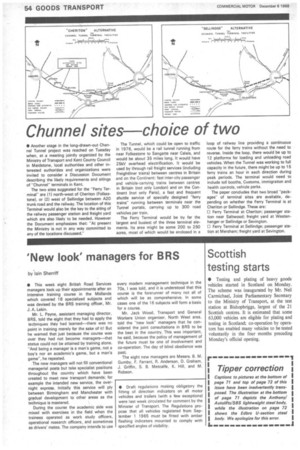Chunnel sites choice of two
Page 56

If you've noticed an error in this article please click here to report it so we can fix it.
• Another stage in the long-drawn-out Channel Tunnel project was reached on Tuesday when, at a meeting jointly organized by the Ministry of Transport and Kent County Council in Maidstone, local authorities and other interested authorities and organizations were invited to consider a Discussion Document describing the likely requirements and sitings of "Chunnel" terminals in Kent.
The two sites suggested for the "Ferry Terminal" are (1) north-west of Cheriton (Folkestone), or (2) west of Sellindge between A20 trunk road and the railway. The location of this Terminal would also be the key to the siting of the railway passenger station and freight yard which are also likely to be needed. However the Document emphasizes that: "At present the Ministry is not in any way committed to any of the locations discussed." The Tunnel, which could be open to traffic in 1976, would be a rail tunnel running from near Folkestone to Sangatte near Calais, and would be about 35 miles long. It would have 25kV overhead electrification, It would be used by through rail freight services (including Freightliner trains) between centres in Britain and on the Continent: fast inter-city passenger and vehicle-carrying trains between centres in Britain (not only London) and on the Continent (not only Paris), a fast and frequent shuttle service of specially designed "ferry trains" running between terminals near the Tunnel portals, carrying up to 300 road vehicles per train.
The Ferry Terminal would be by far the largest and busiest of the three terminal elements. Its area might be some 200 to 250 acres, most of which would be enclosed in a loop of railway line providing a continuous route for the ferry trains without the need to reverse, Inside the loop, there would be up to 12 platforms for loading and unloading road vehicles. When the Tunnel was working to full capacity in the future, there might be up to 15 ferry trains an hour in each direction during peak periods. The terminal would need to include toll booths, Customs, immigration and health controls, vehicle parks.
The paper concludes that two broad "packages" of terminal sites are available, depending on whether the Ferry Terminal is at Cheriton or Sellindge. These are: D Ferry Terminal at Cheriton; passenger station near Saltwood; freight yard at Westenhanger or Sellindge or Sevington.
D Ferry Terminal at Sellindge; passenger station at Mersham; freight yard at Sevington.








































































































































































